Exploring the Impact of Technology in Shipping Logistics
Shipping logistics, the backbone of global trade, has been revolutionized by technology in recent years. From advanced tracking systems to automated warehouses, the integration of technology has streamlined operations, improved efficiency, and enhanced overall customer experience. In this article, we delve into the intricate world of technology in shipping logistics, exploring its various facets, applications, and future implications.
The Evolution of Technology in Shipping Logistics

Over the years, technology has played a pivotal role in transforming the shipping industry. From the early days of manual record-keeping to the advent of sophisticated software systems, the evolution has been remarkable. In the past, shipments were tracked using handwritten logs and paperwork, leading to inefficiencies and delays. However, with the introduction of barcode scanners, GPS tracking, and RFID technology, real-time monitoring of goods has become the norm.
One of the key advancements in recent years has been the development of blockchain technology. By creating a secure and transparent digital ledger, blockchain has revolutionized supply chain management, ensuring greater accountability and trust among stakeholders. This technology has significantly reduced the risk of fraud, theft, and errors in shipping logistics.
Automation and Robotics in Warehousing

Automation and robotics have also reshaped the landscape of warehousing in shipping logistics. With the rise of e-commerce and the growing demand for faster delivery, warehouses have had to adapt to meet these challenges. Automated guided vehicles (AGVs), robotic pickers, and automated sorting systems have revolutionized the way goods are stored, picked, and shipped.
These technologies have not only increased efficiency but also reduced the margin of error, resulting in faster order fulfillment and improved customer satisfaction. By automating repetitive tasks, warehouses can now focus on more complex operations, leading to overall cost savings and increased productivity.
Data Analytics and Predictive Modeling

In the age of big data, data analytics and predictive modeling have become invaluable tools in shipping logistics. By analyzing vast amounts of data, companies can make informed decisions, optimize routes, and predict potential disruptions. This has led to significant improvements in fleet management, inventory control, and overall supply chain efficiency.
Through the use of machine learning algorithms and predictive analytics, companies can anticipate demand, identify bottlenecks, and streamline operations. By harnessing the power of data, shipping logistics firms can stay ahead of the competition and adapt to changing market conditions.
Internet of Things (IoT) and Real-Time Monitoring

The Internet of Things (IoT) has revolutionized the way goods are tracked and monitored throughout the shipping process. By connecting devices and sensors, companies can gather real-time data on shipments, temperature controls, and environmental conditions. This level of transparency has not only improved the safety and security of goods but also enhanced the overall customer experience.
With the ability to track shipments in real-time, companies can proactively address issues such as delays, damages, or theft. By leveraging IoT technology, shipping logistics firms can optimize routes, reduce fuel consumption, and minimize the impact on the environment.
The Future of Technology in Shipping Logistics
As technology continues to advance at a rapid pace, the future of shipping logistics looks increasingly promising. From the adoption of autonomous vehicles to the use of drones for last-mile delivery, the industry is on the cusp of a technological revolution. By embracing innovation and investing in cutting-edge solutions, shipping logistics firms can stay ahead of the curve and meet the evolving needs of customers.
With the rise of artificial intelligence, machine learning, and robotics, the possibilities are endless. Companies that harness the power of these technologies will be able to achieve greater efficiency, reduce costs, and deliver a seamless experience to their customers. The future of shipping logistics is bright, driven by innovation and powered by technology.
Common Misconceptions about Technology in Shipping Logistics
Despite the numerous benefits of technology in shipping logistics, there are some common misconceptions that persist. One of the most prevalent myths is that technology will replace human workers in the industry. While automation has certainly transformed many aspects of logistics, human expertise and decision-making remain crucial in ensuring the smooth operation of supply chains.
Another misconception is that technology is prohibitively expensive and only accessible to large corporations. In reality, technology solutions are becoming increasingly affordable and scalable, allowing companies of all sizes to benefit from the latest innovations. By investing in technology, even small businesses can improve their operations and compete on a global scale.
Conclusion
To wrap things up, technology has become an indispensable part of shipping logistics, revolutionizing the way goods are transported, tracked, and delivered. From automated warehouses to real-time monitoring systems, the impact of technology on the industry is undeniable. By embracing innovation and investing in cutting-edge solutions, shipping logistics firms can enhance efficiency, reduce costs, and improve overall customer experience.
As we look to the future, it is clear that technology will continue to play a central role in shaping the shipping logistics industry. By leveraging the power of data analytics, automation, and IoT, companies can stay ahead of the curve and meet the demands of an increasingly globalized market. The future of shipping logistics is bright, driven by innovation, and powered by technology.




